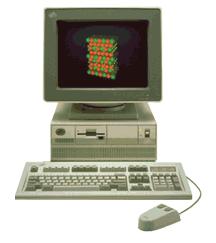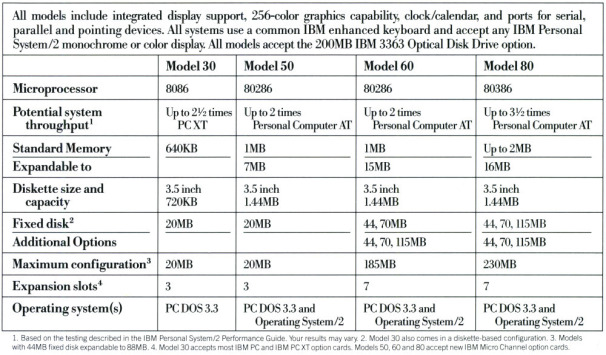IBM PS/2 Model 50
Introduction
The Model 50 (IBM Model 8550) was one of the four originals which were announced on 2nd April 1987, which comprised the Model 30, 50, 60 and 80. Designed to directly replace the IBM PC/AT, it came with an Intel 80286 microprocessor which clocked at 10 MHz with one wait state. It also came as standard with 1 MB of RAM, a high-density 3½" 1.44 MB floppy disk drive and a 20 MB ST-506 hard drive. Just like the other models in the range, several display options were available including a 12" monochrome, or 14", 16" or 19" colour monitor. These drove the new MCGA display adapter.
Unlike the lower-end Model 30, the Model 50 got IBM's new Micro Channel Architecture (MCA) bus which the Model 60 and 80 also had. This was part of IBM's strategy to regain control of the PC market, by designing a new proprietary bus that clone manufacturers would have to licence to use.
For the operating system, IBM launched OS/2 which was supposed to be the standard operating system for the PS/2 range, although it still supported IBM PC-DOS.
Here is the chart from an early magazine advert showing the specs of the four original PS/2 computers:
A sister model, the IBM PS/2 Model 50Z was an enhanced version of the Model 50 that was released later following reports of poor performance by the 80286-10 processor and the 20 MB hard disk. With the 50Z, IBM reduced wait states from 1 to zero, and replaced the sluggish 20 MB hard disk for a faster 60 MB ESDI one. Other changes made with the 50Z were a more tightly-integrated motherboard, resulting in a much smaller board, the non-standard 512Kx9 memory modules were replaced with a single PS/2 SIMM, and other components were put onto smaller riser boards.
Sub-Models
IBM 8550-021 (1 MB RAM, 20 MB "hardfile", 1.44 MB floppy disk drive, 101-key keyboard) - list price $
Optional Accessories
IBM offered the following options for the Model 50:-
Personal System/2 80287 Math Co-Processor (#6450356)
Personal System/2 80286 Memory Expansion Option (#6450344)
Personal System/2 80286 Memory Expansion Kit (#6450345)
Personal System/2 1.44MB Diskette Drive (#6450353)
Personal System/2 Mouse (#6450350)
Personal System/2 Dual Async Adapter/A (#6450347)
Personal System/2 Multi-Protocol Adapter/A (#6450348)
Personal System/2 300/1200 Internal Modem/A (#6450349)
Personal System/2 Monochrome Display 8503 (8503001)
Personal System/2 Color Display 8512 (8512001)
Personal System/2 Color Display 8513 (8513001)
Personal System/2 Color Display 8514 (8514001)
Personal System/2 5.25-inch External Diskette Drive Adapter/A (#6450245)
Personal System/2 3117 Adapter/A (#65X1925)
Personal System/2 High Speed Adapter/A (RS-422A)(#65X1905)
IBM 6157 Tape Drive Adapter (#92X1458)
Personal System/2 Display Adapter 8514/A (#1887972)
Personal System/2 8514 Memory Expansion Kit (#1887989)
IBM 3270 Connection (#83X9702)
System 36/38 Work Station Emulation for the Personal System/2 /A Installation Convenience Kit Version 1.0 (#69X6287)
System 36/38 Work Station Emulation for the Personal System/2 /A Adapter & Quick Reference (#69X6279)
Personal System/2 PC Network Baseband Adapter/A (#1501223)
Personal System/2 PC Network Adapter II/A (#1501222)
Personal System/2 Token-Ring Network Adapter/A (#69X8138)
Personal System/2 Data Migration Facility (#1501224)
Compatibility
Hardware - MCA BUS
The Micro Channel Architecture bus was revolutionary compared to the AT bus (as it was called then, before later being coined the "ISA" bus). MCA was a 32-bit bus but was fully 16-bit compliant, and is today almost considered a forerunner to modern Plug & Play, with each MCA card providing an ID to the computer and installation of these cards was a simple matter of running a special config disk which would automatically configure interrupts, etc. Effective data throughput on an MCA bus was about five times faster than the AT bus.
Hardware - BIOS
The PS/2 line actually had two BIOSes. One, called ABIOS, or Advanced BIOS, was designed with the new MCA technology in mind. The second, called CBIOS, or Compatible BIOS, was in place to ensure the system would be fully "backward" compatible with IBM PC-DOS.
Hardware - MEMORY
The PS/2 line unfortunately do not use standard 30-pin memory (despite still having 30 pins). Instead they use a proprietary "IBM" type RAM which have a different pinout than regular 30-pin SIMMs. The originally supplied memory modules had silver cans on top of the chips. When replacing your memory, they don't have to be the metal can type ones - any SIMM with the right [IBM] pinout should work. According to the original IBM specification sheet, the RAM is: 512kb module DRAM (MMK) 100-150ns w. parity.
RAM can also be expanded with some third-party cards, including the AST Advantage/2 RAM expansion/SCSI controller. A 16-bit MCA card, this provides 8 RAM slots and a SCSI interface. It comes with 4 MB pre-installed.
Hardware - POWER SUPPLY
There are no Molex power connectors from the supplied 94W IBM PS/2 power supply. Instead all powered devices (floppy disk drives, hard drives, etc) use a proprietary fitting.
Hardware - FLOPPY DRIVES
The Model 50 and 50Z got the new 1.44 MB 3.5" floppy disk drives as standard.
Hardware - HARD DRIVES
The Model 50's hard disk itself was a Seagate ST-506 MFM drive with 85ms access time. This was considered slow even at launch, with Seagate's other popular 20 MB drive, the ST-225, offering access times of 65ms, and brand new drives were already available offering 28ms. This slow speed was remedied in the Model 50Z with IBM reducing wait states from 1 to zero (which is why it's called 50Z), and replacing the hard disk with a 60 MB ESDI one which was faster.
 The Model 50 BIOS does not include support for ESDI hard disks, whereas the model 50Z does. An optional upgrade for the Model 50 was an ESDI hard disk interface card which includes BIOS extension chips on it.
The Model 50 BIOS does not include support for ESDI hard disks, whereas the model 50Z does. An optional upgrade for the Model 50 was an ESDI hard disk interface card which includes BIOS extension chips on it.
The Model 50Z's hard disk interface was an ESDI card that was installed into one of the MCA slots on the motherboard, and this card had a special slot which resembled an 8-bit ISA slot which the hard disk directly plugs into. With ESDI, the interface is just that - a simple interface between the drive and the motherboard. The actual "controller" in an ESDI drive is integrated into the drive itself in much the same way as IDE drives are today.
HARDWARE - VIDEO
The Model 50 came with IBM's new VGA (Video Graphics Array). It supported the following modes:
40x25 text mode in 16 colours (8x16 character box)
80x25 text mode in 16 colours (8x16 character box)
320x200 in 256 colours, 70 Hz refresh rate - all points addressable
640x480 in 16 colours, 60 Hz refresh rate - all points addressable
Total palette of 262,144 colours.
Compatible with analog displays *only*.
HARDWARE - CPU
The CPU could be upgraded with the IBM 486SLC2-50/25 upgrade kit.
Software
The PS/2 Model 50 came with a "Starter" disk, which was a system disk that booted into IBM PC-DOS. It had a set of utilities on it for configuring the PC as well as diagnostics. See the Downloads section for more details.
Physical
System Unit: 360 (W) x 420 (D) x 140 (H) mm
Weight: 9.55 kg (21 lbs)